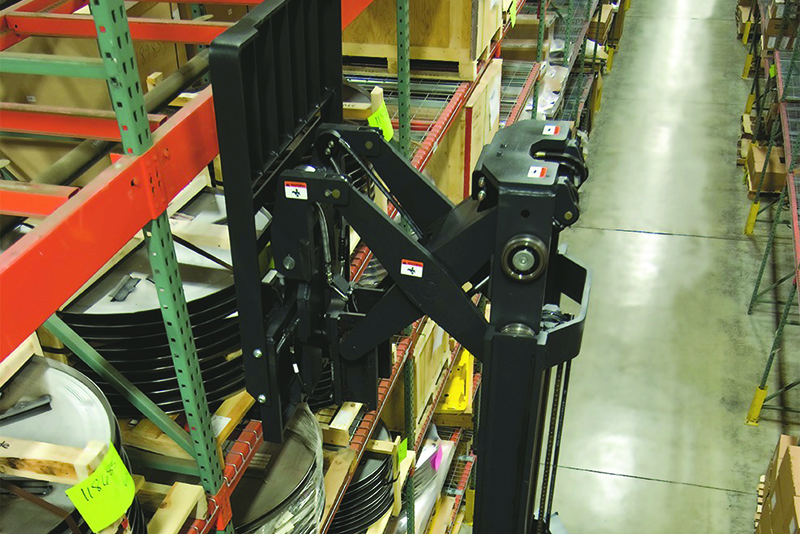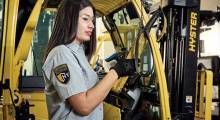The old saying “don’t let the tail wag the dog” applies to selecting the right lift truck equipment for narrow aisle and very narrow aisle (VNA) warehouse configurations.
Yes, wire-guided turret trucks can have impressive reach capabilities and ease of advancing to pick locations, which are ideal for high-density VNA environments. And stand-up reach trucks with ergonomic features are ideal for narrow aisles.
But the first step in selecting the right trucks for narrow aisle initiatives is to first study the storage mediums, rack choices and other layout factors that best meet your operational needs, says Jim Hess, director of Warehouse Business Development with Yale Lift Truck Technologies.
Hess points out that VNA layouts can shrink aisles down to as narrow as the load length plus 18 inches, or about 5.5 feet for a standard 48-inch pallet load. This calls for specialized equipment like turret trucks, which can pivot and handle goods to either side of the aisle, with wire or rail guidance to safely advance the unit and operator to the next position.
Hess notes that Yale offers a turret truck that can reach up to 675 inches, which is just over 56 feet high, to make VNA setups a way to maximize density in buildings with ample clear height. Similarly, narrow aisles, typically 8 feet wide, also create more storage density than a 10- or 11-foot aisle, since less of the warehouse space is consumed by each individual aisle.
Some trucks are ideal for narrow-aisle work, Hess adds, typically stand-up reach truck models offer good features for ergonomics and operator visibility. For some operations, fully autonomous or robotic reach trucks might also be a good fit for narrow aisle workflows, given enough volume around full pallet handling and other considerations like difficulties in finding enough operators.
The first step, however, is tapping expertise from dealers, advises Hess, rather than getting too caught up in the features of specific trucks. Layout assessments will look at pallet material flow, order profiles and assess SKU velocities to determine storage needs for an operation’s fast, medium and slow-moving goods.
“It absolutely makes sense to do a full assessment and study of the operation’s needs first,” says Hess. “For these studies, we train our people to follow the pallet through the entire flow, from receiving to put away, from replenishment to order picking, and finally to shipping. We also will study the number of SKUs, whether SKU counts are growing and by what percentage, and we will break them out to determine the fast, medium and slow movers.”
Such assessments will consider other order profile factors, such as average number of orders per day, the lines per order and piece per line, to determine the best storage and order picking solutions, adds Hess. “We will also look at that order velocity data to assist in slotting recommendations for the warehouse to minimize travel and maximize efficiencies,” he says.
Layout assessments can help with rack choices as well, notes Hess. For example, double-deep racking can come very close to VNA storage density, but by comparison, double-deep rack carries a tradeoff in the speed of access to all pallet positions. “VNA provides a 100% selectivity to the goods in storage, whereas double-deep does not,” says Hess.
Assessments can also help with other storage decisions that involve tradeoffs, such as load beam length in rack design. A shorter load beam will bring greater storage density, whereas a longer load beam will reduce storage density, but a longer beam can help with truck capacity at height in that the truck can be little wider at the base arms to better straddle the load and help with capacity at height, explains Hess. A longer beam and a bit more spacing between loads also tends to help operator productivity in accessing and handling loads. “There are ways to design the truck and the rack to achieve a good balance for a site’s needs,” adds Hess.
Most operations will call for three storage mediums to accommodate fast, medium and slow moving SKUs, adds Hess. Some sites may benefit from VNA, and all sites should pay attention to slotting strategies, such as putting the fastest moving product toward the bottom rack positions, to reduce lift time and improve operator and fleet productivity.
Once the larger layout concerns are addressed, then it’s time to consider the advantages of particular types of trucks and features, like ergonomic features in stand-up units for narrow aisle, or the energy efficiency of reach trucks and how that influences the frequency of battery charging.
Other features like wire-guidance, Hess adds, help with speed and productivity because wire guidance advances the truck and picker to the next pick location without having to steer. Trucks used for case order picking can also be customized to enhance productivity or provide an added measure of safety.
Given the pace of change in DCs, even if a layout study was done a few years back and a move to narrow aisle wasn’t made, it may be time to reassess, Hess says, with the help of a study that can be done with just a little time and access to operational data.
“The answers are all there in the operation’s data, so it makes sense to sit down together to discuss the operational needs and challenges first,” adds Hess.
Article topics










